

What to do with stretched out succulents. How to save stretched out succulents Once a succulent is stretched out, it won’t revert back to it’s original compact height and shape.
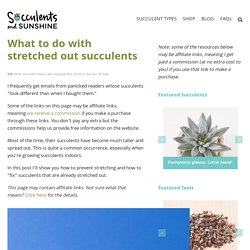
Don’t worry though! There is a way to get back to a tight, compact garden again. Start by cutting off the top of the succulent using sharp scissors (I love, love, love this pair! Absolutely worth every penny!). While I’ve had bare stems send out new offshoots, it takes much longer than when I’ve kept a few leaves on the stem. Be sure to leave enough stem on the cutting to plant in soil later. Let both the cutting and the base dry out for a few days. I’ve found that cuttings need to be watered slightly more often than a fully rooted plant, but not much. The cutting should start to put off roots, possibly within a couple days, but definitely within 2-3 weeks.
The base, or original plant, will start to put off new offshoots within a few weeks. The leaves you left on the base plant originally may fall off or die at some point. Give them more light. Choosing the Right Pot for your Succulents. How To Make A Succulent Christmas Tree. This year has certainly changed our lives. 2020 has been the year of the coronavirus, civil unrest, and bad news.

Many of us have spent a lot of time away from our loved ones, so coming up on the festive season is a good way to turn things around. Likely, things are going to be different this year so perhaps it is time to start a new tradition. People are now creating holiday trees for almost every holiday. Rather than having a large pine tree in your home, you can try downsizing with a succulent holiday tree. Why are the bottom leaves of my succulents dying? Why are the bottom leaves of my succulents dying? Successfully Growing Succulents. I fell in love with succulents 7 years ago when I was still in school and my Mom encouraged me to get some plants to deal with the crazy inversion we used to get each winter.

I started with 3 succulents on my tiny window sill but if you’re anything like me, you’d know that those 3 quickly turned into hundreds and my love for succulents turned into a full-blown obsession. So much so, I moved away from professional photography to full-time succulent ‘addict’. ;) But the road wasn’t easy… I struggled during the early days because I couldn’t find solid, reliable and perfect-for-me resources to help me grow my succulents and make them thrive. Most information, both in books and online, focuses on the perfect climate. FACT: Even though I’m the best-selling author of the Idiot’s Guides to Succulents AND the creator of the Successfully Growing Succulents course, I killed plenty of succulents in the beginning because of failed experiments and misguided advice. How to Water Succulents without Drainage. There are some amazing planters and pots for succulents that don’t have drainage holes.
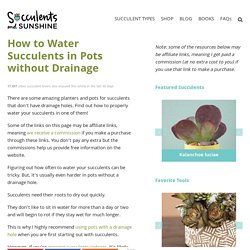
Find out how to properly water your succulents in one of them! Some of the links on this page may be affiliate links, meaning we receive a commission if you make a purchase through these links. You don’t pay any extra but the commissions help us provide free information on the website. Figuring out how often to water your succulents can be tricky. But, it’s usually even harder in pots without a drainage hole. Succulents and Sunshine. You see… most people say the #1 killer of succulents is over watering, when in fact it is the soil.
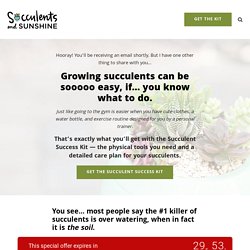
This commonly overlooked aspect of succulent care is your secret weapon to having colorful, healthy succulents decorating your windowsill. Many soils that claim to be “well draining” end up staying wet waaaaaay too long for succulents. Resulting in black, mushy stems and leaving you feeling discouraged that you’ve lost yet another succulent. It’s not your fault! Most commercially prepared “succulent mixes” are just the same as regular potting soil with a little bit of perlite or bark added in.
DIY Driftwood Planter- Use Any Old Wood! Succulents Diy 141 - decoratio.co. Succulents Diy 146 - decoratio.co. Succulents Diy 156 - decoratio.co. Succulents Diy 19 - decoratio.co. Texas Plant Disease Diagnostic Lab. Written by Hannah Ayala – Extension Assistant Like all plants, your succulent could be suffering because of a plant pathogen, an insect pest, or an abiotic factor.
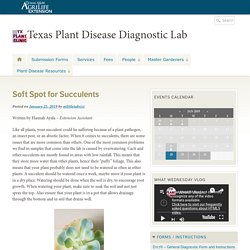
When it comes to succulents, there are some issues that are more common than others. One of the most common problems we find in samples that come into the lab is caused by overwatering. Cacti and other succulents are mostly found in areas with low rainfall. This means that they store more water than other plants, hence their “puffy” foliage. Succulents Diy 34 - decoratio.co. Succulents Diy 157 - decoratio.co. Succulents Diy 32 - decoratio.co. 50+ Creative Succulent Planters You Can DIY - decoratio.co. Succulents Diy 65 - decoratio.co. Succulents Diy 125 - decoratio.co. How To Make Your Own Book Planters for Succulents.
Succulents Diy 133 - decoratio.co. Succulents Diy 15 - decoratio.co. Succulent Identification Chart - find your unknown plant here. This Succulent Identification Chart can help you find your plant: check the general description for some similar plants.
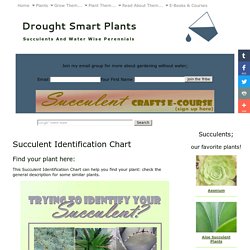
Save Luckily for us, succulents come in all shapes and sizes. Notice whether your plant is spiky, chubby, rosette forming or even has baby plants hanging from the edges of the leaves to guide you to more information on similar plants. The many types of succulents that you can find in nurseries, garden centers, as a cutting from a friend or in large box stores is absolutely astounding. With the interest in these plants widespread and on a level bordering on fanaticism, it's hard to keep up with all the new and interesting introductions, and many times these plants are grouped into collections in the store, without proper labels. How to Grow and Use Aloe Vera. Everyone needs an aloe vera plant on the kitchen window, close to the stove.

Aloe is renowned for its ability to cool and heal a burn. And for that reason alone, you should keep one as a plant ally. But did you know that aloe has other uses as well? Aloe is a “first aid kit in a plant” according to Rosemary Gladstar. [3] Externally aloe vera gel is useful for skin irritation, wounds, scratches, and bedsores, as well as burns. It is also used in hair tonics for it’s reputation as a hair growth stimulant. Aloe vera re-potting – All things green. The Aloe vera plant has been popular for decades as a balm or salve used to treat minor burns, cuts, sunburn and other maladies.

Every household should have an Aloe plant as part of their first-aid kit. You can do your part to spread the good news about Aloe by dividing your plants and giving them away to folks who don’t have an Aloe yet. It’s very easy to do. As an Aloe plant grows, it forms small plantlets or off-shoots around the base of the main stem. They may or may not have roots. How to Water Succulent Plants.
Step One - How To Plant Succulents in Containers. DIY Tiered Succulent Planter. Tips for Growing and Harvesting Aloe Vera. Aloe vera — of which there are about 450 species1 — is a succulent plant that thrives in tropical areas of the world and is well-known for its soothing qualities, especially for skin conditions such as burns, rashes, cuts and scrapes, but also for more serious skin conditions such as psoriasis.

In one study,2 aloe vera gel had an overall antipsoriatic activity of nearly 82 percent. Aloe vera has spiky, variegated leaves, made up of: The outer rind — The tough, protective layerAloin — A yellowish bitter-tasting sap between the rind and the inner gel that helps protect the plant from animals. The aloin has laxative properties and should not be ingested on a regular basis as it may cause serious health complications.3 This portion of the leaf may also exacerbate intestinal health problems such as Crohn's disease and ulcerative colitisPulp or parenchyma tissue — The fleshy inner portion of the leaf, which includes cell walls and mucilage,4 a clear, viscous liquid within the cells. 多肉植物の水栽培にチャレンジ!やり方や育て方は?